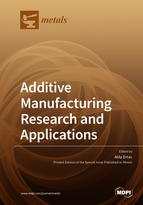Additive Manufacturing Research and Applications
A special issue of Metals (ISSN 2075-4701). This special issue belongs to the section "Additive Manufacturing".
Deadline for manuscript submissions: closed (31 December 2021) | Viewed by 59211
Special Issue Editor
Interests: test method development; galling; transdisciplinary complex system design; 3D printing technology
Special Issues, Collections and Topics in MDPI journals
Special Issue Information
Dear Colleagues,
Additive Manufacturing (AM) has gone through to a certain extent of a revolution over the last decade and now it has evolved into a viable industrial manufacturing solution—creating complex geometries unachievable with traditional manufacturing methods. However, further research required to overcome many challenges additive manufacturing faces today. We welcome you to this special issue of “Additive Manufacturing Research and Applications” to submit papers in the following general research areas of additive manufacturing: powder manufacturing technologies in 3D printing, pre- and post-processing technologies and approaches, AM processes and optimizations, inspection processes and quality evaluation, new materials for 3D printing, design and simulation in AM (topology optimization, microstructure design, new AM machine design and development etc.), and any other interesting research topics regarding 3D printing (additive manufacturing).
Prof. Dr. Atila Ertas
Guest Editor
Manuscript Submission Information
Manuscripts should be submitted online at www.mdpi.com by registering and logging in to this website. Once you are registered, click here to go to the submission form. Manuscripts can be submitted until the deadline. All submissions that pass pre-check are peer-reviewed. Accepted papers will be published continuously in the journal (as soon as accepted) and will be listed together on the special issue website. Research articles, review articles as well as short communications are invited. For planned papers, a title and short abstract (about 100 words) can be sent to the Editorial Office for announcement on this website.
Submitted manuscripts should not have been published previously, nor be under consideration for publication elsewhere (except conference proceedings papers). All manuscripts are thoroughly refereed through a single-blind peer-review process. A guide for authors and other relevant information for submission of manuscripts is available on the Instructions for Authors page. Metals is an international peer-reviewed open access monthly journal published by MDPI.
Please visit the Instructions for Authors page before submitting a manuscript. The Article Processing Charge (APC) for publication in this open access journal is 2600 CHF (Swiss Francs). Submitted papers should be well formatted and use good English. Authors may use MDPI's English editing service prior to publication or during author revisions.
Keywords
- Additive manufacturing
- 3D printing
- Detecting voids in a material
- Powder-Based 3D Printing
- Post processing






